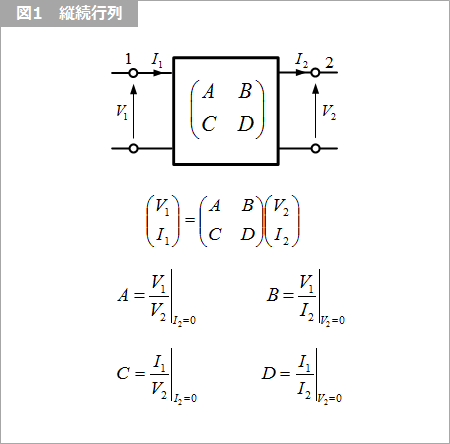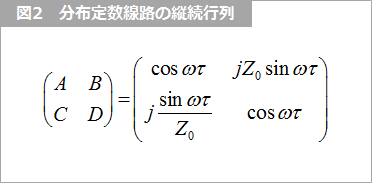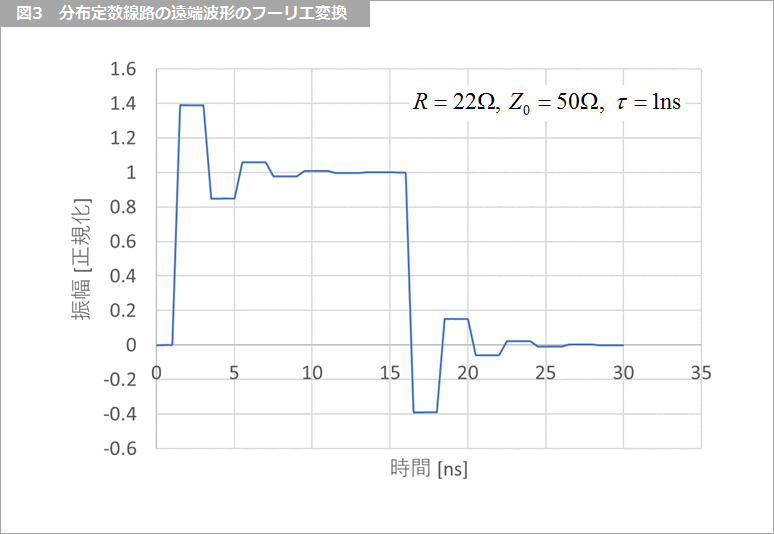In other times, I have talked about `` Vertical Sequence'', `` Laplace Transform and Fourier Transform'', and `` FFT with Excel''. By using this basic knowledge in combination, it is possible to express the distributed constant line with a mathematical expression, and even to obtain the reflected waveform. Don't think it's difficult, use each basic knowledge.
vertical row
Figure 1 shows the relationship between the voltage and current in the cascade. A, B, C, and D can be obtained by the formula shown in Figure 1.

right-handed and left-handed waves
As a preliminary step, the voltage and current in the distributed constant line are
Voltage = right wave + left wave
Current = right wave - left wave
is represented by The right-handed wave is the Laplace transform formula
f(ta) ⇔ exp(-as)F(s)
is used. f(ta) becomes f(0) at time t=a, that is, the origin means that it is delayed by a. In other words, it represents the wave at the place advanced by time a to the right. Left-hand waves, on the contrary,
f(t+a) ⇔ exp(as)F(s)
is used.
Equations for voltage and current
If u is the speed of the signal (wave), the delay time from the origin (near end) to the distance x is x/u. The voltage at x is
V=A1*exp(-sx/u)+A2*exp(sx/u)
The current is
I=(A1*exp(-sx/u)-A2*exp(sx/u)}/Z0
becomes. A1, A2 are constants determined by near-end and far-end boundary conditions. Here, if s=jω, it becomes a frequency function, and FFT can be used.
If the delay time of the line is τ, the near-end and far-end voltages and currents are
V1=A1+A2V2=A1*exp(-jωτ)+A2*exp(jωτ)
I1=(A1-A2)/Z0
I2=A1*exp(-jωτ)/Z0-A2*exp(jωτ)/Z0
is represented as
A and C in a vertical row
A and C open terminal 2 (far end) because I2=0.
I2=A1*exp(-jωτ)/Z0-A2*exp(jωτ)/Z0=0
that's why,
A1*exp(-jωτ)=A2*exp(jωτ)
i.e.
A2=A1*exp(-2jωτ)
therefore,
V2=A1*exp(-jωτ)+A2*exp(jωτ)=2A1*exp(-jωτ)
The near-end voltage is
V1=A1+A2={1+exp(-2jωτ)}A1
that's why,
A=V1/V2={1+exp(-2jωτ)}/{2A1*exp(-jωτ)}
={exp(jωτ)+exp(-jωτ)}/2
becomes. Here, Euler's formula
exp(jθ)=cos(θ)+jsin(θ)
Using,
A = cos(ωτ)
becomes.
Calculating C under the same condition I2=0 gives
I1=(A1-A2)/Z0=A1/Z0{1-exp(-2jωτ)}
V2=2A1*exp(-jωτ)
therefore,
C=I1/V2=A1/Z0{1-exp(-2jωτ)}/{2A1*exp(-jωτ)}
={exp(jωτ)-exp(-jωτ)}/(2Z0)
Similarly, using Euler's formula,
C=jsin(ωτ)/Z0
becomes.
B and D in a vertical row
Next, to find B and D, since V2=0,
V2=A1*exp(-jωτ)+A2*exp(jωτ)=0
that's why,
A2=-A1*exp(-2jωτ)
therefore,
V1=A1+A2={1-exp(-2jωτ)}A1
I2=A1*exp(-jωτ)/Z0-A2*exp(jωτ)/Z0
=2A1*exp(-jωτ)/Z0
therefore,
B=V1/I2={exp(jωτ)-exp(-jωτ)}*Z0/2
Using Euler's formula,
B=jZ0sinωτ
becomes.
Then find D.
I1=(A1-A2)/Z0=A1/Z0{1+exp(-2jωτ)}
D=I1/I2={1+exp(-2jωτ)}/{2*exp(-jωτ)}
Using Euler's formula,
D=cos(ωτ)
becomes.
Transfer function of distributed constant line

Fig. 2 shows the longitudinal series of distributed constant lines obtained above. Once the vertical sequence is obtained, the transfer function can be obtained using "Vertical Sequence" Figure 3 Transfer Function.
For simplicity, if R1=R and R2=∞,
F(ω)=1/(A+RC)
=1/(cosωτ+jR/Z0sinωτ)
becomes.
Waveform analysis by FFT
The iFFT (inverse transform) of the pulse waveform was described in "FFT by Excel". The pulse waveform at this time is multiplied by F(ω) above to perform the inverse Fourier transform. Multiplication of complex numbers in Excel uses the improduct function.

Figure 3 shows the analysis results of 1024 points. The pulse width is 15 ns and the period is 30 ns, but if the period is short, the next pulse will come in the middle of the reflection, so a correct single-shot response cannot be obtained. Conversely, if the actual period is short, you can obtain the response for that period. Please use them properly.
What is Yuzo Usui's Specialist Column?
It is a series of columns that start from the basics, include themes that you can't hear anymore, themes for beginners, and also a slightly advanced level, all will be described in as easy-to-understand terms as possible.
Maybe there are other themes that interest you!
